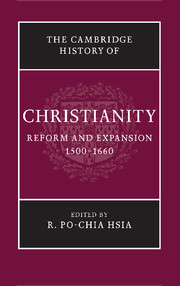Book contents
- Frontmatter
- Part I Luther and the Holy Roman Empire
- Part II The Second Reformation
- Part III Catholic Renewal
- Part IV Resolving Confessional Conflicts
- 13 Peace without concord: religious toleration in theory and practice
- 14 Imposing church and social discipline
- 15 Persecutions and martyrdom
- 16 The Mediterranean Inquisitions of early modern Europe
- 17 Religious colloquies and toleration
- 18 Western Christianity and Eastern Orthodoxy
- Part V Religion, Society, and Culture
- Part VI Christianity and Other Faiths
- Bibliography
- Index
- References
15 - Persecutions and martyrdom
from Part IV - Resolving Confessional Conflicts
Published online by Cambridge University Press: 28 March 2008
- Frontmatter
- Part I Luther and the Holy Roman Empire
- Part II The Second Reformation
- Part III Catholic Renewal
- Part IV Resolving Confessional Conflicts
- 13 Peace without concord: religious toleration in theory and practice
- 14 Imposing church and social discipline
- 15 Persecutions and martyrdom
- 16 The Mediterranean Inquisitions of early modern Europe
- 17 Religious colloquies and toleration
- 18 Western Christianity and Eastern Orthodoxy
- Part V Religion, Society, and Culture
- Part VI Christianity and Other Faiths
- Bibliography
- Index
- References
Summary
Christian martyrdom was dramatically reborn in the sixteenth century, as devout men and women proved willing to die for their respective, divergent views of God’s truth. Depending upon national and local contingencies, Anabaptists, magisterial Protestants, and Roman Catholics were subjected to judicial trials for their violation of laws that prescribed correct religious belief and practice. Those who refused to recant were often executed. From the 1520s into the seventeenth century, this basic confrontation between capital judicial procedure and committed religious belief resulted in some 5,000 deaths for religion in Europe, the majority of which occurred in the Low Countries, France, and England. The extensive memorialization of these deaths by martyrologists and the communities of faith to which they belonged played an important role in the shaping of distinct, separate Christian traditions in early modern Europe and beyond.
Viewed broadly, the thrust of executions for religion during the era shifted from Anabaptists in the 1520s and 1530s to Reformed Protestants in the 1540s and 1550s, to Roman Catholics after 1580 in England, Asia, and the Americas. Nearly 500 known or ‘probable’ executions of Anabaptists had occurred in central Europe, including Switzerland and Bohemia, within a decade of the first deaths in 1525. In the Low Countries, the followers of David Joris and Menno Simons would experience more of the same in the years just after the fall of the Anabaptist kingdom of Münster in 1535. The number of Protestant martyrs grew with the proliferation of Calvinism in the 1540s and 1550s. In France, the Parlement of Paris issued only twenty-three death sentences for heresy from 1536 through 1543, for example, but 112 from 1544 through 1549.
- Type
- Chapter
- Information
- The Cambridge History of Christianity , pp. 261 - 282Publisher: Cambridge University PressPrint publication year: 2007
References
- 1
- Cited by

